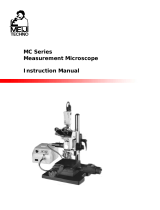Page is loading ...

DE2510Series–User’sGuide
BarefiberInterferometer
Features:
HighresolutionvideoandCCDcamera
20xnon‐contactinterferometer
Pitch‐Yawstageforfiberalignment
ManufacturedbyDomailleEngineeringLLC,theDE2510SeriesVideoMicroscope
aredesignedforvisualend‐faceinspectionoffiberopticconnectorsina
productionenvironment.
DE2510:Equippedwitha±20°tiltinggoniometerandinterferometer,thismodel
isprimarilyusedforbarefiberinspection.
Withinthismanualisalltheinformationneededtooperateandmaintainthe
DE2510SeriesVideoMicroscope.DomailleEngineeringLLC,isalwaysdesigning
innovativenewproductswhilemaintainingandfurtherdevelopingexistingones.
PrintingHistory
Edition2,April2014
©Copyright2014byDomailleEngineeringLLC
Parts&Functions
(Chart&Image)
InitialSetup
AfterunpackingtheME2510seriesmicroscopeandaccessories,setupcanbequicklyachieved
throughafewsimpleconnections.Therearethreemaincomponentstothemicroscopesystem,
themicroscope,powersupply,andmonitor(orcomputerusingaframegrabber).
TheME‐12013LEDControlleroperatesfroma24voltDCoutputpoweradapter(ME‐12015)with
switchingtransformertoacceptACvoltage90‐240volt,50‐60Hzfordomesticorinternational
use.ThisunitisusedtopowerboththeCCDCameraandtheilluminationofthemicroscope.
Currentlyweprovidetwodifferentmanufacturer’smodelmonitors,inseveraldifferentsizes.
Thesemonitorsarehighresolutionmonitorsspecificallychosentoprovidethebestsolutionfor

inspectingconnectorend‐faces.Wedonotrecommendanyofthelowerpricedsecuritytype
monitorsastheresolutionandimagequalityarenotsufficient.Acomputermayalsobeusedto
captureimages,contactDomailleEngineeringformoreinformationondigitalcameraoptionsor
videoframegrabbers.
Focusing
ThefocusadjustmentknobontheDE2510seriesisconvenientlylocatednexttothestage.
Turningtheknobadjuststhecontrastoftheimagewithprecisionandcontrol.
Clockwise=Focusesthestagein
Counter‐Clockwise=Focusesthestageout
Lighting
TheilluminationcanbecontrolledusingtheintensitycontrolknoblocatedontheME‐12013
LEDController.Thisallowstheoperatortocontrolthebrightnessoftheimagewheninspecting
thedarkfibercladdinghighlyreflectivemetalorceramicferrules.
Forgreateramountofcontroloverthelighting,theME‐12013LEDControllerisequippedwith
a3turnelectronicrheostat.OlderanalogmodelsmaybeupgradedbycontactingDomaille
Engineering.
Clockwise=IncreasesIllumination
Counter‐Clockwise=DecreasesIllumination
ChangingMagnifications
TheDE2510isequippedwiththreeobjectiveslenses:5x,10x,anda40x.Mountedtoatypical
microscopeturretornosepieceallowstheoperatortoquicklychangemagnificationswhen
inspectingconnectors.Optional3.3xand40xobjectivesareavailable.
Formoreinformationonmagnificationorcalibrationseeourwebsiteat
www.DomailleEngineering.com
UsingtheScope
StageAdjustments
1. FocusorY‐axisadjustmentmovestheentirestageassemblyforwardandbacktofocus
thefiber.

2. HorizontalorX‐axisadjustmentmovesthebarefiberholderlefttoright,alongthe
horizontalplane.
3. VerticalorZ‐axisadjustmentmovesthebarefiberholderupanddownalongthe
verticalplane.
4. Pitchadjustmenttiltstheangleofthebarefiberholderfromtheforetoaft.
5. Yawadjustmentrotatesthebarefiberholderfromlefttoright.
AdjustingBareFiberHolder
Dependingonthediameterofthebarefiber,itmaybenecessarytoadjustthesetscrewsto
applythecorrectamountoftensiontosecurethefiber.
1. Placethefiberintothefiberholderandclosethedoor.
2. SlowlytightenthesetscrewclosesttotheobjectivesuntilthefiberwillNOTslideinand
out.
3. Tightenthe2ndsetofscrewsforaddedsupport.
4. Whenthefiberneedstoberotated,simplyliftthedoorbeforerotating.
AlignmentofStage
Itisnecessarytomakesurethatthebarefiberholderisperpendiculartotheopticsinorderto
getacorrectcleaveanglecalculationusingtheinterferometer.
1. Placethecalibrationpininthebarefiberholder,makingsurethepinissecureatthe
bottomofthe“V”
2. Usingthe5xobjectivelensfocusonthecalibrationpinandcentertheimageusingtheX
andZaxisadjustments.
3. Repeattheprocessusingthe10xand20xobjectivestomakesurethepinisvisibleon
themonitor.
4. Usingtheinterferometer,focusinonthecalibrationpinfringes.
5. UsingthePitchandYawadjustmentsonthestage,tiltthestageuntilonly1fringeis
visible.
6. Rotatethecalibrationpinandcheckthefringesagain.Oncethecalibrationpincanbe
rotatedatanydegreeand1fringeismaintainedthestageisperpendiculartotheoptics.
Procedureforcheckingbarefibercleave
Thenon‐contactinterferometerlensprovidesvaluableinformationaboutthetopographyof
thefiberendface.Thispatternofthesurfacealsooffersinformationaboutthequalityofthe
cleavingtool,breakpoint,andanystressthatmayhaveoccurredduringthebreak.
1. Placethebarefiberintheholder,makingsurethepinissecureatthebottomofthe
“V”.Itisrecommendedtoleaveapprox.3mmoffiberstickingoutbeyondtheholder.
2. Usingthe5xobjectivelensfocusonthecalibrationpinandcentertheimageusingtheX
andZaxisadjustments.

3. Repeattheprocessusingthe10xand20xobjectives.Usethe20xobjectivetocheckthe
surfacequalityofthecleaveforchips/debrisand/orhackle(roughsurfacearea).
4. Usingtheinterferometer,adjustthefocuscarefullyuntilthefringescomeintoclear
view.
5. Onceyouhaveaclearimagewiththeinterferometer.Rotatethefiber(simplyliftthe
dooronthefiberholdertorotate)andfocustheinterferometeragain.Thesamefringe
patternshouldbemaintained.Ifnotthestagemayneedtobere‐aligned.
6. CountthenumberofDARKfringestocalculatecleaveangle.Refertothechartonthe
(nextpage).
InterferometricAnalysisofCleavedFiber
Thefringecountwillvaryaccordingtodifferentfiberdiameters
Pleasenote:Themarginoferrorasresultoffixturesormisalignmentoftheholdercanbe±
1.5fringes.
FRINGESPERDEGREEFORVARIOUSFIBERDIAMETERS
FiberDiameterFringeCountPerDegree
80µm5.8
125µm8.9
140µm10.1
230µm16.7
TheangleofthefibercanbecalculatedbycountingthenumberofDARKfringesonthefiber
endfaceanddividebytheappropriatecountoffringesperdegree.Typicalcleaveanglesare1
degreeorless.
Calculationsbehindtheanalysis:
Tangentof1degree=H÷D=Nλ ÷2D
Tangent of 1 degree = 0.01745
H = Height of the fiber away from the reference mirror inside of the micrometer
D = Diameter of the fiber in microns
N= Number of fringes per degree
λ = Wavelength of light ( blue LED is approx. .480 microns)
λ÷2 = Height of 1 fringe

Using a 125 micron fiber as an example:
0.01745 = (N x .480) ÷ (2 x 125)
N = 8.9
Using a 80 micron fiber as an example:
0.01745 = (N x .480) ÷ (2 x 80)
N = 5.8

Interferograms Representing Individual and Combinations of Aberrations




Preventive Maintenance
Caution:
Thefollowinginstructionsshouldonlybeperformedbyqualifiedservicepersonnel.
Ifequipmentisusedinamannernotspecifiedbythemanufacturer,the
protectionprovidedbytheequipmentmaybeimpaired.
ThereisNOSERVICEABLEEQUIPMENTinsidetheME‐12013LEDController.All
equipmentrequiringrepairshouldbesentbacktothemanufactureroran
authorizeddealer.
Note:TheDE2510seriesmicroscopeisrelativelylowinmaintenance.Basiccareandprecautioninusing
theinstrumentisrequired.Dependinguponthecleanlinessofthegeneralworkingareaaswellasthe
ageoftheequipment,wewouldsuggestatleastsemi‐annualserviceandmaintenance.
GeneralCleaning
Harshsolventsarenotrecommendedonaregularbasis.Typicalsafedegreasersolventscanbe
usedtocleanoldgreaseorgrimefrommechanicalparts.Lenscleanerissafetouseonthe
opticsofourmicroscopes.Lenscleanercanbeusedwithasoftlenstissue/clothtoremoveany
soil,fingerprints,etc.Fromthefrontoftheobjectives.
Centeringtheillumination
CenteringtheilluminationoftheDE2510iscriticalinordertomaximizeperformanceofthe
microscope.Allscopesaresetupfromthefactory,butreplacinglampsorperiodiccleaningof
thebeamsplittermayrequiretheoperatortore‐centertheillumination.
1. Usinga3/32”hexwrench,loosenthefoursocketheadscrewssurroundingthelight
block.
2. Whileviewingafiberonthemonitor,slidethelightblockarounduntilthegreatest
amountoflightisoverthecladdingareaofthefiber.
3. Re‐tightenthefourscrews.

Incorrect Illumination:
Notice how the light is towards the bottom of the screen.
Correct Illumination:
Notice how the light surrounds the cladding. Light scratches can now be easily detected.
Cleaningobjectivelenses
Oils,dirt,andfingerprintsmayreducetheresolvingpoweroftheobjectivelenses.Toensure
maximumlevelsofperformanceoftheDE2510series,wipethelensoftheobjectiveswitha
lint‐freetissueandlenscleaner.Ordinarylenscleaner,availableatmostphotographysupply
storesworksthebest.Performthisprocedureweeklyorasneeded,dependingonthetypeof
environmentinspectionisbeingheld.
CleaningtheCCDCamera
Useextremecautionwhenattemptingtocleanthecamera.Anyscratches,solvent,streaksordirtleft
ontheIRfilteroftheCCDwillshowupinthefieldofviewofthemicroscopes.

BeforeattemptingtocleantheIRfilterontheCCDcamera,firstconfirmthatthevisibledirton
themonitorisactuallyonthecamera.Whileviewingthesuspecteddirtonthevideomonitor,
slowlyrotatetheCCDcameraontheMicroscope.
DuetotheorientationoftheCCD,ifthedirtremainsinthesamespotanddoesnotrotatewith
thecamera,thenitmostlikelyisonthecameraitself.
1. Carefullyunscrewthecamerafromthecameramount.
2. Usingclean,compressedair,blowacrossthesurfaceoftheIRfilter.
3. Recheckthecamerafordirt.
4. Ifthedirtisstillthere,useplastictweezers,softlensclothandlenscleanertocarefully
wipethesurfaceoftheIRfilter.Useawipingspiralpatternfromcenteroffilteroutto
edges,toremovedebris.
5. Re‐checkthecamerafordirt.
6. Repeatthisprocessuntilthecameraisclean.
BlowairacrossandnotdirectlyattheCCDsensorofthecamera.
Determiningactualmagnification
Thebestmethodtocalculatetheexact“total”magnificationusedontheDE2500seriesisto
measurethecladdingonthevideodisplay.Takethemeasurementinmillimetersanddivide
thatamountbythe125microncladding.Theresultisthe“total”opticalandvideo
magnificationbeingused.
Forexample:takingasetofcalipers,wemeasuredthediameterortheferruleviewedthrough
DE2510onamonitortobeapproximately
Actualsizeondisplay/claddingdiameterinmm=totalmagnification
53.49mm/.125mm=427.92X
Lubricatingthefocusmicrometer
Occasionallubricationofthefocusmicrometerwillensureaccurateandrepeatableresults.

1. Unscrewthefocusknobandcarefullyremovethemicrometerdrum
2. Cleanthemicrometerdrumwithdegreaser
3. Lubricatethedrumandthreadswithalightgrease
4. Carefullyreplacethemicrometerdrumbyscrewingitbackintothehousing.
/





